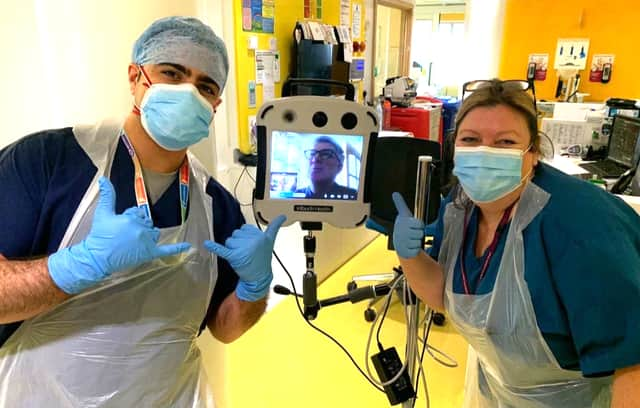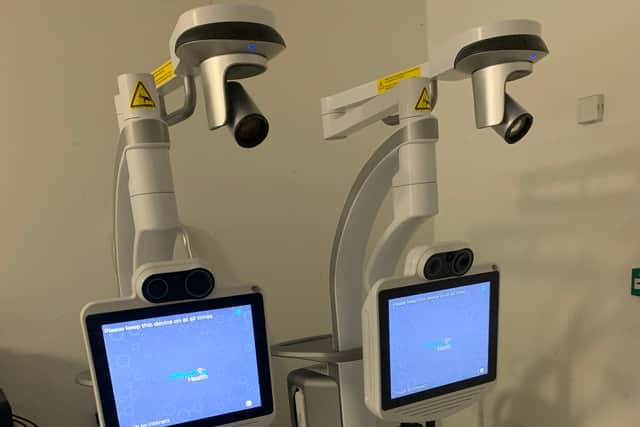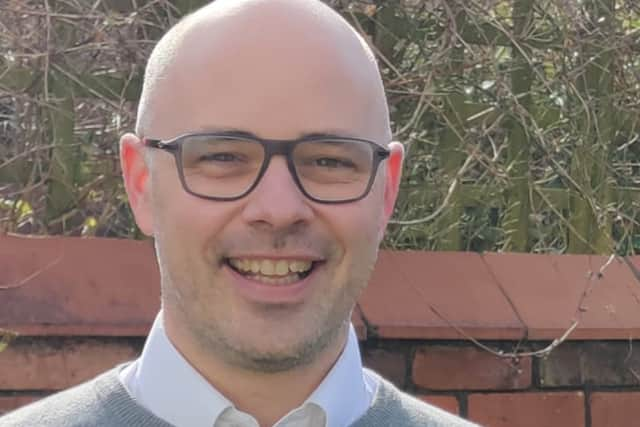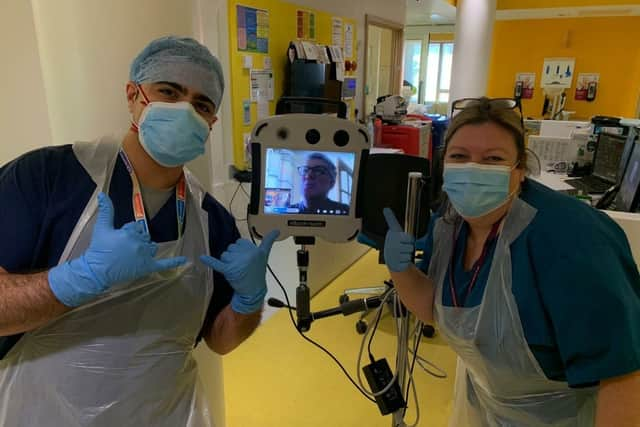Robots helping pioneering Liverpool hospitals care for babies


Babies in Liverpool are being cared for through robotic technology that allows doctors and clinicians to be at their bedside virtually.
The telemedicine robots are fitted with a TV screen, high definition zoom camera and audio capability that allows medics to interact with staff, patients and their families.
Advertisement
Hide AdAdvertisement
Hide AdThe technology, which was first used in Alder Hey Children’s Hospital NHS Foundation Trust and Liverpool Women’s NHS Foundation Trust (LWH) back in April 2019, initially proved invaluable when the Covid-19 pandemic badly affected staffing levels.
The robots enabled consultants to continue their rounds on hospital wards while they were shielding or isolating at home.
The initiative is spearheaded by Dr Chris Dewhurst, who is a consultant neonatologist and clinical director for the Liverpool Neonatal Partnership, which provides neonatal services across both hospitals.
LiverpoolWorld caught up with Dr Dewhurst to find out more. He had just finished his ward round via one of the robots as he was isolating due to his daughter testing positive for Covid-19.


How did it all start?
Advertisement
Hide AdAdvertisement
Hide Ad“In 2019 we were building a surgical neonatal unit at Alder Hey, so that any babies born at LWH who needed an operation could go to Alder Hey to receive the same care,” Dr Dewhurst explained.
As part of the process a representative from the Mayo Clinic, a non-profit American academic medical centre, visited the neonatal partnership in early March 2019 to discuss how telemedicine could be used in care.
“A few days later everyone could see how COVOID-19 was impacting Italy and I thought we could be heading for trouble in the UK. It was at that time I knew we needed the robot,” Dr Dewhurst said.
He explained they found a supplier and a robot arrived from a hospital in Spain on March 24.
Advertisement
Hide AdAdvertisement
Hide Ad“It was just in time, because seven out of 14 consultants were suddenly either shielding or isolating and just 50 percent of consultants were trying to provide a service across two hospitals.”
The consultants who were at home were trained to use the robot and on April 6 the first virtual ward rounds happened at Alder Hey and LWH.


How does it work?
Dr Dewhurst, a consultant neonatologist for 11 years, said the system offers opportunities for the future but it has already provided huge benefits throughout the pandemic.
He explained: “Staff who were in hospital didn’t have to provide extra cover and those who were at home could still be part of the team. Most importantly the babies got to be seen by a doctor every day.
Advertisement
Hide AdAdvertisement
Hide Ad“Connecting hospital Wi-Fi could sometimes be a challenge, but overall staff were happy with the system and families said they were able to build relationships with some of the doctors even though they had never met them in person.’
‘We realise it’s not the same as face-to-face consultations, but it made our service sustainable during the pandemic and the babies didn’t need to move to another city to be cared for.”
“Today I wasn’t able to do a ward round but I’ve been able to zoom in on the babies in their cots and have a general view of the room. I’ve been able to speak with nurses and other doctors and come up with a treatment plan.”
The telemedicine robots from INTouch Health, have two high definition cameras which allow clinicians to obtain a clear view of a baby, according to Alder Hey. The cameras can zoom into every detail, with the main cameras being able to zoom up to 24x and the boom camera having the ability to zoom up to 36x.
Advertisement
Hide AdAdvertisement
Hide AdThe technology also has a port where devices such as stethoscopes or scanners with a USB or HDMI cable attached can be plugged in, allowing the clinician who could be at home or working from another site, to make more accurate clinical decisions.


Facts and figures
Liverpool Neonatal Partnership has one of the largest neonatal intensive care services in the UK with 44 cots at LWH and nine at Alder Hey providing support to over 1,200 babies a year.
There are now five robots being used across the two Liverpool hospitals and for other children’s services for remote consultations.
The NHS Trusts saved approximately £30,000 a month in locum fees.
Advertisement
Hide AdAdvertisement
Hide AdThe robots cost £80,000 to £100,000 each and were funded by Alder Hey Children’s Charity.
The family
In May last year Zalena Bagnall’s baby Sam was born prematurely at Arrowe Park Hospital, Wirral, at 24 weeks gestation, weighing just 1lb 11ozs. He then spent time in between Alder Hey and LWH and had emergency surgery as his organs hadn’t developed and his bowel ruptured. Sam was then sent back to LWH to have an opportunity to grow bigger.
Ms Bagnall and her husband Martin are from South Cheshire and LWH provided a hospital apartment so they could be near their son at a critical time.
Ms Bagnall told LiverpoolWorld: “Under normal circumstances a surgeon would travel from Alder Hey to check on his wound regularly. A week following surgery Sam’s wound started to weep, but there was no way for a surgeon to jump in a car and go across the city like they normally do.
Advertisement
Hide AdAdvertisement
Hide Ad“That’s where the telemedicine robots came in. We used it throughout our time in hospital, the surgeon could zoom in on the wound and you felt like they were in the room.
“There’s nothing quite like having someone there in person, but during a very stressful and scary time for us I genuinely don’t know what we would have done without the robots. During lockdown this became the norm and it saved so much time as the surgeons could see Sam immediately when they needed to.
“We’ve been home since September last year and Sam is doing really well. We have even been offered the chance to keep in touch with the team through telemedicine via our local hospital if we need to.”
What’s next for the robots?
Dr Dewhurst is speaking through online technology to a global health conference in Las Vegas this week about the innovation and how it has helped the city.
Advertisement
Hide AdAdvertisement
Hide AdLiverpool Neonatal Partnership have also shared details on the innovation with NHS England and talks have been held regarding how the initiative could be rolled out across the North West.
LWH has announced plans for the redevelopment of their existing neonatal unit and there are plans for a new neonatal intensive care unit opening at Alder Hey in 2022.
“Staff looking after a pre-term baby born in Warrington or Blackpool for example, could use specialists at Alder Hey or LWH for immediate support,” Dr Dewhurst explained.
“It would be a huge project, but it would mean a specialist who was two hours away could be at a cot side in 30 seconds.”
Comment Guidelines
National World encourages reader discussion on our stories. User feedback, insights and back-and-forth exchanges add a rich layer of context to reporting. Please review our Community Guidelines before commenting.